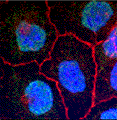Biochemistry, Department of
ORCID IDs
0000-0003-2397-3131 (JEM)
Document Type
Article
Date of this Version
9-23-2008
Citation
Proceedings of the National Academy of Sciences of the USA (September 23, 2008) 105(38): 14,727–14,731
doi: 10.1073/pnas.0805089105
Abstract
Very-long-chain fatty acids (VLCFAs) are synthesized as acyl-CoAs by the endoplasmic reticulum-localized elongase multiprotein complex. Two Arabidopsis genes are putative homologues of the recently identified yeast 3-hydroxy-acyl-CoA dehydratase (PHS1), the third enzyme of the elongase complex. We showed that Arabidopsis PASTICCINO2 (PAS2) was able to restore phs1 cytokinesis defects and sphingolipid long chain base overaccumulation. Conversely, the expression of PHS1 was able to complement the developmental defects and the accumulation of long chain bases of the pas2–1 mutant. The pas2–1 mutant was characterized by a general reduction of VLCFA pools in seed storage triacylglycerols, cuticular waxes, and complex sphingolipids. Most strikingly, the defective elongation cycle resulted in the accumulation of 3- hydroxy-acyl-CoA intermediates, indicating premature termination of fatty acid elongation and confirming the role of PAS2 in this process. We demonstrated by in vivo bimolecular fluorescence complementation that PAS2 was specifically associated in the endoplasmic reticulum with the enoyl-CoA reductase CER10, the fourth enzyme of the elongase complex. Finally, complete loss of PAS2 function is embryo lethal, and the ectopic expression of PHS1 led to enhanced levels of VLCFAs associated with severe developmental defects. Altogether these results demonstrate that the plant 3-hydroxy-acyl-CoA dehydratase PASTICCINO2 is an essential and limiting enzyme in VLCFA synthesis but also that PAS2-derived VLCFA homeostasis is required for specific developmental processes.
Includes Supplementary material.



Comments
Copyright 2008, National Academy of Sciences of the USA. Used by permission.